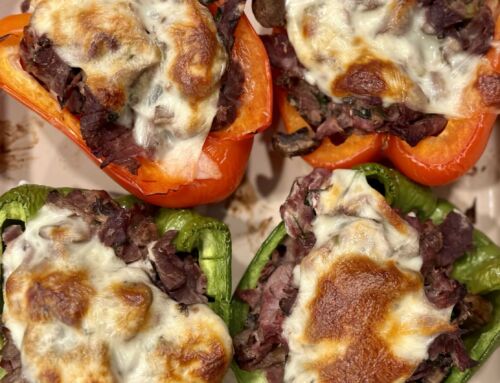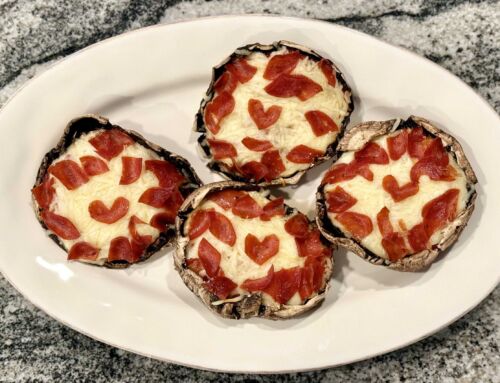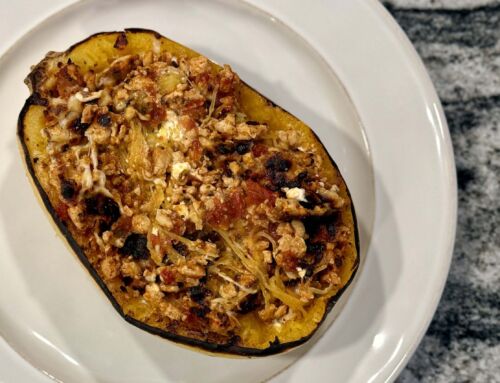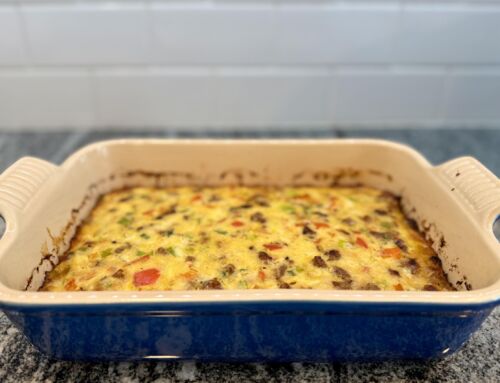Before Ed and I were married, we enjoyed some wonderful meals at the now long gone Iberian on Long Island, New York with Vickey and Bob B and Stephanie and Bill M. We always had their wonderful paella and sangria. It is still our standard for good paella.
Paella is a wonderful dish from Valencia, Spain. It is traditionally cooked outside in a large round pan over a heat source (coals or gas) and often made in very large quantities. Two ingredients are key for paella – Spanish rice (such as bomba) and saffron. From there, you’ll see three types of Paella – Valencian (made with various meats), Seafood and Mixed/Mixta (a combination of seafood and meat).
A few years ago Ed suggested we make paella at home. The universe must have been listening as shortly after he said that, I received an email from Milk Street about a stovetop paella pan that they recommended. Milk Street does a thorough job of vetting the products that they promote. I’ve purchased a few different things from them over the years and have always been very pleased, so I opted for the Garcima Pata Negra 15-Inch Paella Pan that they suggested.
We adapted a recipe from Lauren Allen’s Tastes Better from Scratch. Lauren had lived in Madrid and got this recipe from a wonderful cook there. She then adapted it back at home in the United States using a large skillet. We made this recipe three times to get it right. This included some changes like adding more spice and realizing we needed to cover the dish (while heating) for the clams to cook. And we used our stovetop paella pan.
This is one of the original one pot meals. While there are a fair amount of ingredients and the recipe may look complex, it’s actually pretty easy to make. It’s a perfect weekend meal when you have time to prep and follow the cooking steps. Nothing should be rushed. I originally used the large oblong middle burner (intended for a griddle) on our stove thinking that would be the best heat source, but found that the traditional large round burner worked best with this 15-inch pan. From prep to the table is about 1-1/2 hours. Some of the prep work can also be done in advance.
We were ready for primetime when we made it the fourth time. Last fall we connected with Alex N and Vivi M. They are seniors at Villanova University – about 20 minutes from our house. Alex’s mom, Marianne, and I have been friends since high school. We promised them a paella meal before they graduated. It came out perfectly – well cooked and we achieved the crispy crust that forms on the bottom, called a socarrat. The tip – don’t stir the rice. I know it’s hard (especially for Ed) not to stir the rice, but don’t do it.
This dish serves six but that doesn’t stop us from making it for the two of us. If we do, we’ll eat the seafood (shrimp and clams) and some of the meat the first night, and then enjoy leftovers on another night. We’re not a fan of leftover seafood so this plan works well for us.
Want to pair this paella with sangria? Here’s a recipe for Red Sangria.
| Paella Mixta | Print |
- 5 cups chicken broth
- 2 chorizo links, cut into ¼-inch rounds (see Notes)
- 2 tablespoons extra virgin olive oil
- 1 large yellow onion, diced
- 1 red pepper, diced
- 4 medium garlic cloves, minced
- 1 14-ounce can of petite diced tomatoes (do not drain)
- 1 tablespoon smoked paprika
- 1-1/2 teaspoons Piment d'Espelette (see Notes)
- 1 teaspoon saffron threads, crumbled
- 1 bay leaf
- Kosher salt and freshly ground black pepper
- ½ cup dry white wine
- 4 boneless, skinless chicken thighs, cut into 1-inch pieces
- ¼ cup fresh chopped parsley chopped, divided
- 2 cups bomba rice (see Notes)
- ½ cup frozen peas
- ½ pound large shrimp (about 12), peeled
- ½ pound clams or mussels (about 12) (see Notes)
- Garnish with lemon slices
- Add broth to a medium pot and bring to a boil over high heat. Watch carefully so it doesn’t boil over. Once boiled, turn the heat to low to keep it simmering.
- Using a 14 or 15-inch paella pan or skillet, heat chorizo rounds, stirring, until brown, about 10 minutes. Transfer chorizo to a plate and set aside.
- In the same pan, heat olive oil over medium heat. Add the onion, red pepper and garlic. Cook until the onion is translucent, stirring occasionally, about 10 minutes.
- Add the diced tomatoes, smoked paprika, saffron, Piment d'Espelette, bay leaf, ½ teaspoon Kosher salt (or to taste) and ¼ teaspoon freshly ground black pepper. Stir and cook for 2 minutes.
- Add white wine and cook for 10 minutes. Taste and add additional Kosher salt, if needed.
- Add chorizo rounds, chicken pieces, 2 tablespoons chopped parsley and rice to the pan. Cook, stirring for 1 minute.
- Pour the broth slowly all around the pan and jiggle the pan to get the rice into an even layer. Once achieved, do not stir the mixture going forward (I know you will be tempted to do so – please refrain.)
- Bring the mixture to a boil. Reduce heat to medium low. Give the pan a gentle shake back and forth just once or twice during cooking.
- Cook (uncovered) for about 15-18 minutes.
- Nestle the shrimp and clams or mussels into the mixture. Sprinkle peas on top. Cover with a lid or one or two pieces of aluminum foil. This ensures that the shrimp cooks and clams or mussels open up. Continue to cook (without stirring) for about 5 to 8 more minutes.
- Watch for most of the liquid to be absorbed and the rice to be tender. (If for some reason your rice is still not cooked, add ¼ cup more water or broth and continue cooking). Discard any unopened clams or mussels before serving.
- Remove the pan from the heat, and keep covered for an additional 5 minutes.
- Remove the bay leaf before serving.
- Garnish with fresh parsley and lemon slices.
* I originally used the large oblong middle burner (intended for a griddle) on our stove thinking that would be the best heat source, but found that the traditional large round burner worked best with this 15-inch pan.
* Piment d'Espelette (or Espelette pepper) is made from chilies from the Basque region of France and Spain. You can find it in spice stores or online. If you don’t have it, substitute 1 teaspoon Aleppo pepper for 1-1/2 teaspoons Piment d'Espelette or 1-1/4 teaspoons sweet paprika and ¼ teaspoon cayenne pepper.
* If you prefer not to use chorizo, add 2 more chicken thighs (so you have 6 chicken thighs).
* You want to use Spanish rice for paella. Bomba (also called Valencia rice or Rice de Valencia) is the most traditional but you can also use Calasparra rice. You’re more likely to find it online or in an international market. Do not use arborio rice (which is used in risotto) as the creamy consistency it creates isn’t right for paella. The rice should be tender and dry when it’s done.
* Why don’t you stir the rice? The perfect paella has a crispy crust that forms on the bottom, called a socarrat.
* We typically use clams rather than mussels because our local fish store sells clams individually while the mussels are sold in two pound bags. That’s too many mussels for this recipe.
Source: Variation of a recipe from Tastes Better from Scratch







We learned at our paella class in Sevilla paella is always made stove top, and never in the oven. He never mentioned about covering it when using shellfish (clams and mussels), but just let shrimp cook directly in the broth. I feel I would want to cover it, as well. Beautiful dish, and I’ve been searching for a paella pan that will work on magnetic induction. But I do have a 16 inch skillet which works just fine.
David – That is so interesting about always cooking it on a stovetop. That makes me feel more authentic. If you’re only using shrimp, I don’t think you need to cover it, but there wasn’t enough broth to cook the clams (or mussels). Thank you for sharing!